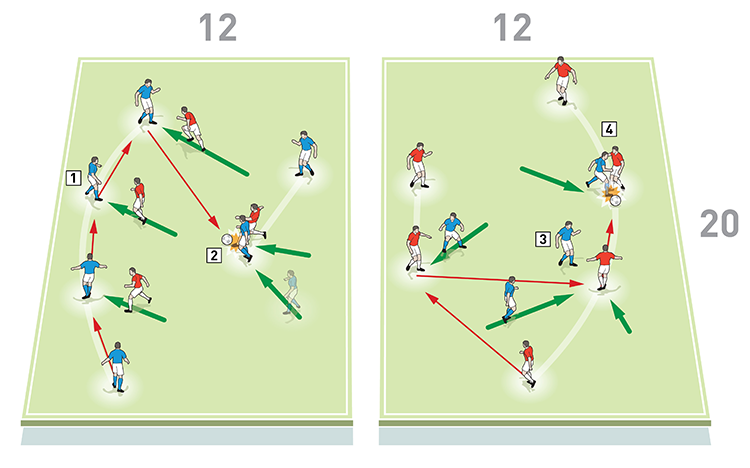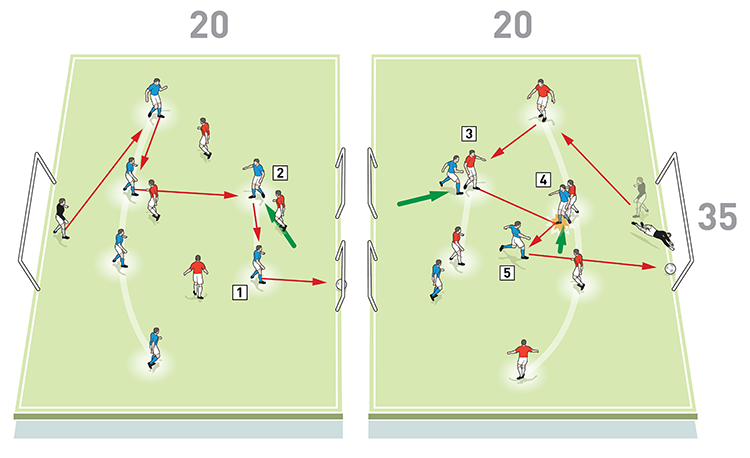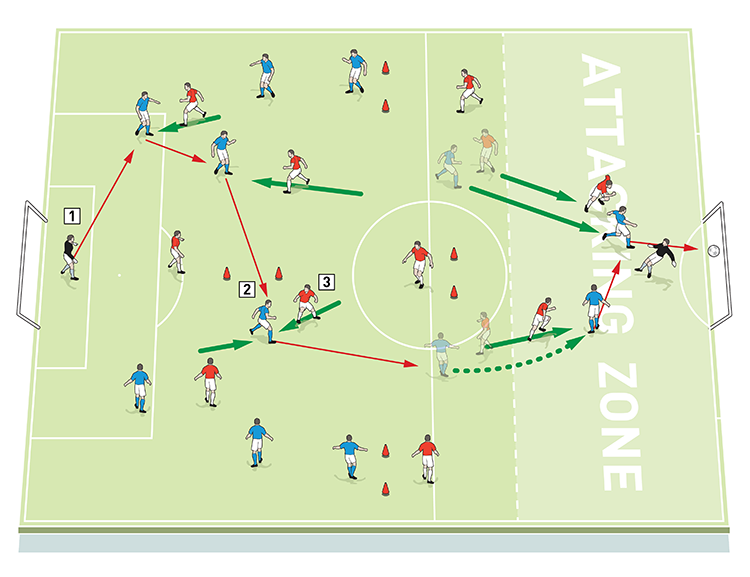High press

| Area | Up to full pitch |
| Equipment | Balls, bibs, cones, 2 full size goals, 4 mini goals |
| No. of Players | 20 players + 2 goalkeepers |
| Session Time | Total: 80mins (including warm-up), Positional practice: 11mins, Game scenario: 22mins, 11v11 conditional game: 26mins |
This session is all about pressing high. It will help both individual roles and team movement when pressing opponents in their own half of the pitch, starting from their defensive third.
Pressing high gives your team the chance to regain possession as soon as possible and gives players the opportunity to create goal scoring opportunities, either through quick and positive play or though a purposeful possession-based attack.
The high press makes your team want to dominate with a daring and commanding approach to the game. It is also about forcing mistakes early on, to deny the opposition the opportunity to advance into your half of the pitch in an efficient manner.
I would certainly run this session a few times in pre-season to make sure the team understand it, and then I would revisit it once every couple of weeks, to ensure it becomes an integral part of our team’s DNA.
What do I get the players to do?
Positional practice
After a warm-up (not shown), create two separate but adjacent areas of 12x20 yards, as shown [1]. Split your players into two teams of 10 and play a 6v4 in each area, with each team having a back four and two midfielders in one area and a front four in the other. In each area, the back four starts with the ball and the team of six must try to keep possession using all of their players, preventing the four pressing attackers from getting hold of the ball.
1

2. Four red forwards cover the area and press to regain the ball while the blues hold positional shape. Here red pressing pays dividends
3. Here the blue centre forward fails to split the two red central defenders to prevent the pass
4. The nearest blue forward to the defender presses high and gains possession. You want to see the forwards winning the ball in both areas
In doing so, it’s important that the team of six use a positional approach with full backs and centre backs operating as they usually would, and the centre midfielders creating movement to use the space. The front four must also use a positional approach, pressing and covering across the area, and using the highest forward to split the centre backs and the nearest forward to the centre back in possession to press the ball.
You want to see the front four winning the ball – make it a competition between the two practice areas to see which front four can win the ball the most times. Play four sets of 90 seconds or two minutes, with one minute’s rest in between sets.
Game scenario
Set up two separate but adjacent areas of 20x35 yards, with one full size goal and two mini goals, as shown [2]. Use the same formation set-up as in the positional practice, splitting your players into two teams of 10 and playing a 6v4 in each area, with each team having a back four and two midfielders in one area and a front four in the other. However, this time add a goalkeeper in each main goal. The team of six must keep the ball below waist height.
2

2. The red front four must press to regain possession and score past the keeper
3. In this area, it’s the red back four and two midfielders who must score in the mini-goals, while the blues are forwards
4. Here the blue centre forward splits the central defenders to prevent them passing to each other and he gains possession
5. The blue forward scores in the main goal. See if the blues here can score more than the red forwards in the other area
The aim for the team of six is to score in the mini-goals, while the front four must try to regain possession and score against the keeper in the main goal. Like the first session, this is competitive – see how many goals one front four can score compared to the front four in the other area.
Progress this part of the session by restricting touches for the keeper and the team of six. You could also progress it by turning the two 6v4 practices into 5v5s, moving a centre midfielder from each team of six into the team of forwards in the other area.
Play four sets of four minutes, with two minutes to rest between sets.
11v11 conditional game
Set up on an 11v11 pitch, using an area from one goal line up to the edge of the opposite penalty area, with a full size goal at each end. Create an attacking zone from the deepest edge of the centre circle up to the edge of the penalty area and place four five-yard gates in the areas shown [3].
3

2. The team in possession has to pass or dribble through a gate before entering the attacking zone and attempting to score
3. The team out of possession has to force play, as here. If they regain the ball, they should try to score against the keeper in the 18-yard box
The team in possession has to either pass or dribble through one gate before they are allowed to enter the attacking zone to score. The team out of possession has to force play and if they manage to regain possession they must try to score against the keeper in the 18-yard box. The offside rule applies from the halfway line.
You can progress the game by increasing the amount of gates the team in possession needs to go through before being allowed to score, plus you could try setting a limit on passes, touches and time. You can also try removing the gates and allowing the team in possession to play into the attacking zone from an outfield player’s pass.
Play four sets of five minutes with two minutes to rest in between sets. Each team plays two sets as the pressing team and two sets as the team in possession.
What are the key things to look out for?
Look for your pressing players to force play, box opponents in, and regain possession. You need to see a desire to score quickly, or to secure possession and then to score if they were prevented from scoring quickly. It’s also important to make sure your centre forward “shuts the gate” by splitting both centre backs and preventing them from passing to each other.
What are the typical mistakes that players might make, and how do you avoid them?
Beware of the centre forward becoming too impatient – that is “butterflying” (going everywhere without any purpose) and trying to win the ball too early. The key is for him to box his opponent into a small section of the playing area, avoid the switch and then regain possession if he reads a mistake – but his main role is to stay central in case his team regains possession, so he can be found to score.
Once the opposition players are boxed in, the pressers must move as a team. Again, they must be patient. First they must force play to make the play predictable by narrowing the attacking/passing options of their opponents. Then they must “bite”, to regain possession.
How would you put this into a game situation?
You could play an 11v11 game on a full pitch, with both teams instructed to work on the high press.
Editor's Picks
Attacking transitions
Deep runs in the final third
Using the goalkeeper in build-up play
Intensive boxes drill with goals
Penetrating the final third
Creating and finishing
My philosophy
Pressing initiation
Compact team movement
Coaches' Testimonials

Alan Pardew

Arsène Wenger

Brendan Rodgers

Carlos Carvalhal

José Mourinho

Jürgen Klopp

Pep Guardiola

Roy Hodgson

Sir Alex Ferguson

Steven Gerrard
Coaches' Testimonials

Gerald Kearney, Downtown Las Vegas Soccer Club

Paul Butler, Florida, USA

Rick Shields, Springboro, USA

Tony Green, Pierrefonds Titans, Quebec, Canada
Join the world's leading coaches and managers and discover for yourself one of the best kept secrets in coaching. No other training tool on the planet is written or read by the calibre of names you’ll find in Elite Soccer.
In a recent survey 92% of subscribers said Elite Soccer makes them more confident, 89% said it makes them a more effective coach and 91% said it makes them more inspired.
Get Monthly Inspiration
All the latest techniques and approaches
Since 2010 Elite Soccer has given subscribers exclusive insight into the training ground practices of the world’s best coaches. Published in partnership with the League Managers Association we have unparalleled access to the leading lights in the English leagues, as well as a host of international managers.
Elite Soccer exclusively features sessions written by the coaches themselves. There are no observed sessions and no sessions “in the style of”, just first-hand advice delivered direct to you from the coach.









